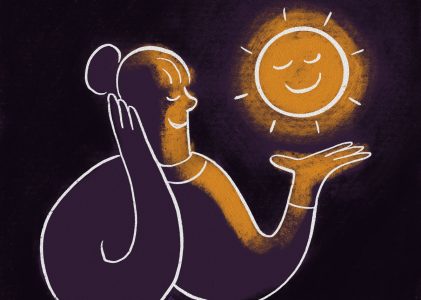For some of us, the end of daylight savings time earlier this week blew the lid off a creeping seasonal depression that started so small and grew so slowly, we hardly noticed it. Now fully fledged and unconstrained, seasonal depression wraps around us like a thick vine, sapping our energy and making us feel sluggish and dull. (yawn) Is it bedtime yet?
But, wait! Before you crawl back into bed, there’s something simple you can do to beat back winter blues and feel like yourself again. It’s called light therapy.

As the days get shorter and darkness falls earlier, do you notice that you feel moody, listless, sluggish or less motivated? Do you crave high-carb foods, sleep too much or have more trouble concentrating? Do your symptoms tend to start in the fall and get better in the spring?
Mild symptoms that don’t keep you from doing what you need to do are commonly referred to as “winter blues.” It’s normal to feel a little down during darker months.
If your symptoms are more severe and do interfere with your daily activities, you may struggle with seasonal affective disorder*. About 5% of US adults experience seasonal affective disorder and another 10-20% of Americans experience mild symptoms [1].
Whether you’ve got a mild or severe case, light therapy may help.
What is seasonal affective disorder?
Seasonal affective disorder (SAD) is a type of major depression that follows a seasonal pattern. Symptoms begin around the same time each year and last for approximately 4-5 months. Most people with seasonal depression experience symptoms that begin in the fall and last over the winter months. However, there’s also a less common pattern that starts in the spring and persists through the summer.
SAD symptoms may include the usual symptoms of major depressive disorder:
- Feeling depressed most of the day, nearly every day
- Losing interest or pleasure in most activities, feeling unmotivated or bored, going through the motions
- Feeling sluggish or agitated
- Appetite or weight changes
- Sleep problems
- Low energy or fatigue
- Feeling worthless or excessively guilty, focusing on past failures
- Trouble concentrating or making simple decisions, forgetfulness
- Thoughts of death or suicide
For seasonal depression in the winter, these symptoms are common:
- Sleeping too much
- Withdrawing from social activities (wanting to “hibernate”)
- Craving high-carb foods like sweets, chips, bread products, or potatoes
- Gaining weight
For seasonal depression in the summer, you might experience some or all of these symptoms:
- Sleeping too little
- Feeling restless or agitated
- Poor appetite that leads to weight loss
- Increased anxiety
- Increased irritability
What causes seasonal affective disorder?
Researchers aren’t sure of the exact causes of seasonal depression. However, changes in sunlight exposure may disrupt your circadian rhythm (your internal sleep-wake clock). This clock regulates your sleep, mood and hormones. When it shifts, you may feel out of step with your usual schedule and have trouble adjusting to changes in daylight length [1].
In addition, reduced exposure to sunlight may cause your body to produce too much melatonin (the sleep hormone) and/or too little serotonin (the feel-good brain chemical), leaving you sluggish and down [2].
Genetic factors also may contribute, making certain people more vulnerable to SAD [2].
What is light therapy for seasonal depression?
Light therapy uses a light box that produces bright white light and simulates sunshine. This helps replace natural sunlight and regulate the biological processes that may get disrupted during winter months.
Light therapy can offer relief from seasonal depression. However, for some people, light therapy is more effective when combined with antidepressant medication and/or talk therapy. It’s best to talk with your healthcare provider about using light therapy for seasonal depression.
Note: If you have bipolar disorder or a history of eye problems (e.g., glaucoma, cataracts, eye damage from diabetes) consult your healthcare provider or eye specialist before starting light therapy.
Tips for finding and using a light box
Get enough lux. Lux is a measure of light intensity. Make sure your light box has 10,000 lux exposure.
Limit UV light. Light boxes for SAD should be designed to filter all or most UV light.
Get enough time. Shoot for 20-30 minutes a day. You can do it all at once or spread it out over a few hours. However, using it later in the day may cause insomnia.
Start before 10 am. Morning light may be most effective for setting and maintaining a healthy circadian rhythm.
Don’t stare. Keep your eyes open but don’t stare directly at the light. You can keep the light in front of you or just off to the side and about 16-24 inches from your face (follow the manufacturer’s instructions). Spend your time reading, watching TV, working, eating—whatever works for you.
What are other treatments for seasonal affective disorder?
- Antidepressant medication can improve symptoms of major depression, including seasonal affective disorder.
- Talk therapy – cognitive behavioral therapy (CBT) or other types of counseling can help improve symptoms of seasonal depression.
- Lifestyle measures:
- Get as much natural sunlight as possible. Spend time outdoors (especially in the morning) or increase your exposure to natural light indoors. If you can, plan a trip to a sunny location during the darkest time of the year.
- If you’re able to do so, consider setting up a smart-light system in your home that turns on bright, cool light in the morning (5000-6500K) and then shifts to dim, warm light in the evening (around 2700K). This shift mimics that of sunlight across the day and may help you maintain a healthy circadian rhythm. It’s particularly important to avoid bright, cool light in the evening because this disrupts and delays melatonin production [3] and may impact your sleep quality and quantity.
Next Steps
If you or someone you love struggles with depression and would benefit from professional help, call your doctor or contact Athena Care, for mental health care in Tennessee.
One of our Care Coordinators will help you get the care you need.
*In the Diagnostic Manual of Mental Disorders (DSM-5), Seasonal Affective Disorder is now identified as a type of depression – Major Depressive Disorder with Seasonal Pattern.

Rachel Swan, MS
Editor
Rachel has a Masters of Science in Clinical Psychology from Vanderbilt University, where she spent 16 years as a Research Analyst in the Psychology and Human Development Department.


